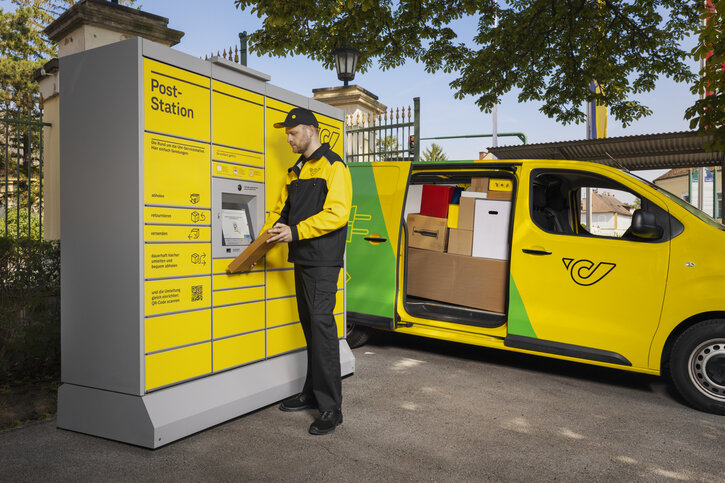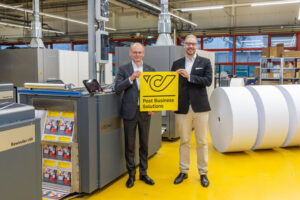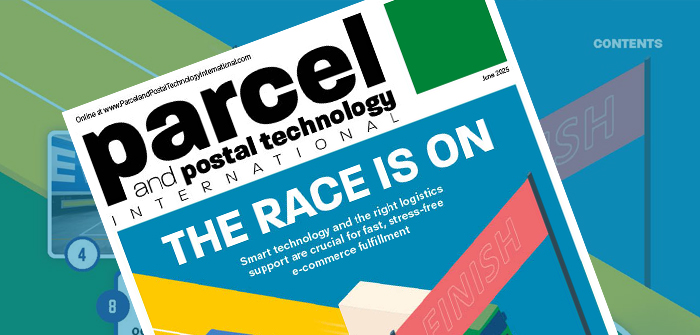At the beginning of May, Austrian Post announced that its new corporate strategy is to become one of the leading logistics and service groups in Austria, Central and Eastern Europe, Turkey and beyond, with over 150 million satisfied customers and revenue of €4bn (US$4.5bn) by 2030 (see Business strategy at the end of this article).
And the post is well on its way to achieving those targets, according to the man at the helm, CEO Walter Oblin. “Over the past 15 years, Austrian Post has undergone a substantial transformation, as many postal companies have,” he explains. “We still have a significant mail business in Austria but of course this is structurally declining. Our parcel business has been the growth engine. Fifteen years ago we transported roughly 100 million parcels; last year that number was more than 500 million in the whole group.”
It may seem surprising that in this modern e-commerce-focused world, a postal operator still sees letters as big business. But for Austrian Post the sector creates €1.2bn (US$1.36bn) in revenue every year, a third of the group’s overall income. “We’re doing everything we can to keep mail relevant,” Oblin confirms. “In Austria, we still deliver 500 million addressed mail items per year; we have a strong and lively direct mail business consisting of both addressed and unaddressed items. We try to offer high quality at moderate prices, and with that strategy I think we’ve managed to keep mail volume decline relatively moderate.”
The post is seeing a decline of 5-6% per year. However, compared with other postal operators this is relatively low – PostNord, for example, has seen mail volumes fall by 90% between 2000 and 2024 and has announced it will discontinue its letter delivery service next year.
Oblin agrees that the fall in letter volumes remains a challenge for Austrian Post, but says that the focus is on amending service levels rather than abandoning the sector altogether. “The challenge is to move volumes into slower products and bundle them in distribution to make it as efficient as possible,” he comments. To achieve this, the post announced in March that it would deliver letter mail in two to three working days as standard from May 1, 2025, with a ‘premium’ service for next working day delivery available for an additional €0.30 (US$0.34) on the cost of each mail type.
“Over 80% of all letters are already sent within two to three working days,” Oblin confirms. “With this simplification, we are adapting our product range to the Postal Market Act and the changing needs of our customers.”
Investing in parcels
Of course, the post has seen a rise in parcel volumes over the past 15 years and is now the market leader in Austria for parcel delivery. Data released by Branchenradar.com Marktanalyse in February confirmed that last year the post grew its share of the parcel sector in the country by 2%, to 56%. This equates to 224 million of the 397 million parcels delivered in the country in 2024.

“We have been investing significantly in capacity in parcels, and we are the clear leader in the Austrian parcel market,” Oblin enthuses, “in particular the growing B2C business. We have been investing in our portfolio in Eastern Europe, and in Turkey we own 80% of Aras Kargo, which is one of the leading Turkish parcel networks. The challenge, of course, in all these markets is dense and intense competition. But with a combination of investment in operational excellence and technology, we try to stay ahead of that competition.”
The company has invested around €1bn (US$1.14bn) in building, expanding and modernizing its logistics centers over the past five years and is conducting commercially viable pilots of robotics, for example for picking parcels or putting them on the sorting belt.
“We have AutoUnloader technology for unloading trucks in a semi-automated way, so there are multiple technologies that are helping us handle parcels more effectively,” Oblin says.
“In the mid to long term, autonomous vehicles are also a technology we are looking at, but probably for operating and moving containers in the logistics center or warehouse rather than in the last-mile delivery to begin with. We think autonomous driving technology will revolutionize our industry in the last mile, but first it will be tested in the sorting centers and our own campuses.”
Austrian Post is also focused on expanding its IT capabilities, where it hopes to stand out from its competitors in the e-commerce fulfillment side of operations. “In Austria, we offer a broader value chain than just delivery – our software and IT company ACL develops and operates e-commerce sites for online retailers,” explains Oblin.
“We also do the logistics and fulfillment of orders in the warehouse close to the airport with a very modern AutoStore system. We’ve just decided in today’s board meeting [on May 20] to make another investment in capacity and automation in this fulfillment center – to be announced!”
Expanding out-of-home capabilities
For Austrians, Oblin says at-home delivery remains the preferred choice. However, the post is expanding its locker network and self-service solutions to remain relevant and futureproof the company as the market changes.

“We are the clear leader in lockers and self-service; we pioneered 24/7 solutions in Austria almost 20 years ago and were the first to offer postal stations [lockers],” Oblin confirms. “We also established the first self-service post branches, and we have invested substantially in the rollout of this solution. Last year more than
30 million parcels were handled via self-service solutions. We continue to build out this network in Austria as well as in Eastern Europe, with a target of around 10,000 lockers in Eastern Europe by the end of 2026.”
The post has also created an in-home delivery service with smart access solution provider Nuki, which won the Last-Mile Delivery Innovation of the Year award at the Parcel and Postal Technology International Awards (see And the winner is…, December 2024).
“We also have multiparty parcel boxes in residential buildings, so we offer a variety of options for home delivery, even when the resident is not at home,” Oblin explains. “Increasingly, customers are choosing lockers as their primary option for receiving parcels – our most recent market research showed that 25% of customers already prefer to receive their parcels in a locker. We think the Austrian market will change but for quite few years more, home delivery will be the primary option. We expect these two options to run in parallel,” he continues.
Sustainable developments
In addition to having a clear corporate strategy, Austrian Post is laser-focused on becoming a leader in sustainable logistics. It has a self-imposed goal of having completely CO2-free delivery processes throughout Austria and exclusively using vehicles with electric propulsion systems in the last mile by 2030.
“We pioneered electric mobility in 2011,” Oblin says, “and now more than 50% of our Austrian delivery fleet is electrified – more than 5,000 electric vehicles. We have a target to eliminate the last combustion engine in our last-mile delivery fleet in Austria by 2030. We are also rolling out these plans and ambitions in the rest of our regional portfolios.”
To enable the rollout of its electric fleet, Austrian Post is also investing heavily in its own charging infrastructure, and does not rely on any public infrastructure to run its electric fleet.

Oblin continues, “Infrastructure is a challenge, but our solution is to build the infrastructure in our depots. We also have solutions in place for postal workers to take their vehicles to their homes and charge them overnight.
“For our truck fleet – the ones that run between logistics centers – we have taken two steps over the past few years. One was to switch from diesel to HVO [hydrotreated vegetable oil] and we have almost neutralized our carbon footprint in the middle mile. This is a transition technology and in parallel we have the first two electric trucks that operate in the middle mile in the Vienna area. We plan to invest in further pilot projects – both technical and commercial – to ensure the viability of electric trucks in our fleet.
“We are expecting the industry to offer affordable trucks in the near future. If that is combined with subsidies from the government to help this technology take off, I think it is within reach to see a fully electric trucking fleet.”
Staying relevant
Oblin remains passionate about the postal sector and positive about the future of Austrian Post. But he knows that to remain relevant, the company must build on its brand and diversify its business.
“Our brand and our postal ecosystem covering more than just mail and parcel helps to defend our strong position in the e-commerce parcel market,” he confirms. “Our strategy is to look beyond post in Austria, so we operate a postal bank under the brand bank99 and we have recently announced we’ll be launching a telecom offering under our own brand next year. We also offer certain business services both in e-commerce fulfillment and in mail transaction printing [see €5m investment at the end of this article] so we are more than just a post.”
When asked what helps make a successful postal operator in a modern world, Oblin provides four main pieces of advice: Try to keep mail relevant, invest in parcel growth, look for opportunities to broaden your service portfolio, and invest in a culture that makes you the employer of choice.
“We employ 30,000 people and we really do invest a lot in being an attractive employer, offering a culture where people have fun, bring performance and find purpose. Only happy staff will make a difference for our customers.”
Business strategy
Austrian Post’s revised corporate strategy focuses on three strategic pillars:
- More than just post: Austrian Post remains Austria’s market leader in the letter and parcel business. It also offers a platform for additional services such as banking, with its bank99 available through post offices, postal partners and digital channels. The telecommunications offering is also being expanded.
- Internationally strong in the parcel business: Austrian Post is a strong player internationally and intends to continue to grow in this area. It will continue to invest in existing markets and develop new ones. With subsidiaries in Southeast and Eastern Europe as well as Turkey and beyond, it serves over 150 million customers with parcel delivery.
- One group of companies – operational excellence: With around 30,000 employees in Austria and abroad, Austrian Post aims to strengthen cooperation and leverage synergies as a group, becoming locally entrepreneurial and internationally networked. It is constantly developing its processes with the aim of achieving operational excellence, and is working to increase efficiency through automation, digitalization, robotics and AI.
 €5m investment
€5m investment
In January, Austrian Post’s subsidiary, Post Business Solutions, announced that it had invested €5m (US$5.25m) in new printing and inserting machines for transactional printing, enabling it to print up to 85 million A4 pages for medium-sized and large businesses every month.
More than 500 customers in Austria – primarily banks, insurance companies and energy providers – will benefit from the new Canon ColorStream 8160 state-of-the-art printing machine, which offers digital color printing and inkjet roll-to-roll printing to achieve twice the print resolution of conventional machines.
With double-sided printing, the new machine can produce more than 2,150 pages per minute at high speed. Together with three new inserting machines from Böwe Systec Austria, it will increase capacity to handle peak loads during the high season.
Transactional printing processes large volumes of documents. Customers who regularly print smaller volumes can use the EinfachBrief web service, which takes care of printing, enveloping and dispatch by the post office, replacing floor printers.
Those who want to create electronic correspondence from a physical letter can use dual delivery (e-letter).
Post Business Solutions also offers numerous digital solutions for business customers, including the e-pay slip, the hybridSign digital signature and the recently launched DAiTA intelligent document processing platform, which uses AI to automate data and document management.
All pictures credited to Austrian Post
This article was originally published in the June 2025 issue of Parcel and Postal Technology International



